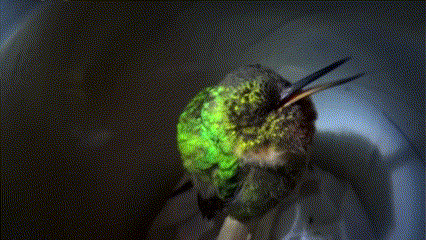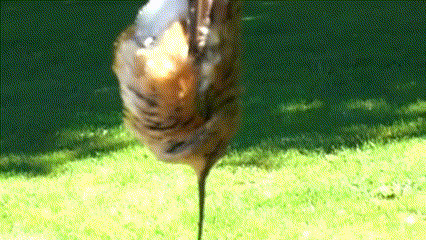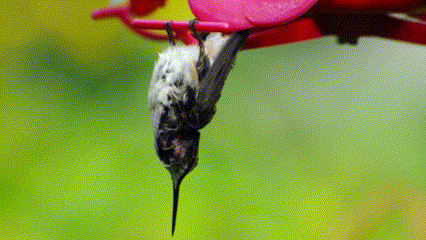Hummingbirds, those dazzling jewels of the sky, captivate us with their iridescent colors, incredible speed, and tireless energy. These miniature marvels are constantly in motion, flitting from flower to flower, fueling their high-octane lifestyle. But even these energetic creatures must rest. This naturally leads to the question: Where Do Hummingbirds Sleep? Considering their delicate size and the constant threats of the wild, understanding their nighttime habits is truly fascinating for bird enthusiasts and nature lovers alike.
This article will delve into the intriguing world of hummingbird sleep. We’ll explore the unique way they rest, where they seek shelter, and address common questions like whether they sleep in nests, near feeders, or even upside down. By understanding where and how hummingbirds sleep, we gain a deeper appreciation for the remarkable adaptations that allow these tiny birds to thrive.
 Hummingbird Migration Patterns: Animated GIF showing the migratory routes of hummingbirds, highlighting their extensive travel for breeding and feeding grounds.
Hummingbird Migration Patterns: Animated GIF showing the migratory routes of hummingbirds, highlighting their extensive travel for breeding and feeding grounds.
The Hummingbird Slumber: Torpor, Not Typical Sleep
While we might imagine hummingbirds settling into a cozy nest for a good night’s sleep like many other birds, their nighttime rest is quite different. Hummingbirds enter a state called torpor. Torpor is a deep, sleep-like state, but it’s more akin to hibernation in mammals. During torpor, a hummingbird’s metabolic rate plummets dramatically – sometimes to as low as one-fifteenth of its normal daytime rate. Their body temperature drops significantly, and their heart rate slows to an almost imperceptible level.
This isn’t just a power nap; torpor is a survival mechanism. Hummingbirds have incredibly high metabolisms, requiring them to consume nectar almost constantly throughout the day to maintain their energy levels. At night, when they can’t feed, torpor allows them to conserve precious energy and survive until dawn. By drastically reducing their energy expenditure, they can endure long, cold nights, especially crucial during colder seasons or migration.
 Hummingbird Torpor Explained: Animated GIF illustrating a hummingbird entering torpor, showing reduced breathing and stillness as they conserve energy overnight.
Hummingbird Torpor Explained: Animated GIF illustrating a hummingbird entering torpor, showing reduced breathing and stillness as they conserve energy overnight.
Hummingbird torpor can be so profound that the birds may appear lifeless. They become still, unresponsive to light or sound, and their breathing is barely detectable. This deep state of rest is essential for these tiny dynamos to recharge and prepare for another day of frenetic activity.
Choosing a Safe Haven: Where Hummingbirds Roost
Where do hummingbirds sleep to ensure their safety during this vulnerable torpid state? Protection from predators is paramount for these small birds when they are essentially defenseless. Hummingbirds are known to seek out sheltered spots, often choosing tree branches or dense shrubs that offer natural camouflage within their environment. These locations provide a degree of concealment, helping them blend into their surroundings and avoid detection by nocturnal predators.
Generally, hummingbirds prefer roosting spots that offer some protection from the elements, such as wind and rain, but not necessarily complete enclosure. They often select branches or perches that are somewhat exposed to air circulation but shielded from harsh weather. These locations are frequently found in close proximity to their feeding areas, allowing them to quickly access food sources as soon as they emerge from torpor at dawn. You might spot a hummingbird perched securely on a slender branch, often hidden amongst leaves, effectively disappearing from view.
 Camouflaged Hummingbirds Sleeping on Branch: Photo of several hummingbirds roosting together on a tree branch, demonstrating their camouflage in natural habitats for protection.
Camouflaged Hummingbirds Sleeping on Branch: Photo of several hummingbirds roosting together on a tree branch, demonstrating their camouflage in natural habitats for protection.
Despite their delicate appearance, hummingbirds possess surprisingly strong feet equipped with specialized tendons that act like locking mechanisms. This allows them to grip branches firmly without expending energy, ensuring they remain securely perched even when in deep torpor. They don’t need to actively hold on, eliminating the risk of falling, even if they were to hang upside down.
Nightly Roosting Habits: Consistency or Variety?
Do hummingbirds return to the same sleeping spot each night? While they might have favorite areas within their territory, hummingbirds are not strictly creatures of habit when it comes to nightly roosting locations. These highly mobile birds can cover considerable distances in their search for food throughout the day. Their sleeping arrangements are often adaptable, influenced by factors like weather conditions and food availability in different areas.
They are known to adjust their roosting site based on environmental factors. For instance, on colder or windier nights, they may opt for denser vegetation for increased shelter compared to milder conditions. During migration, hummingbirds are constantly exploring new territories and will select suitable trees or shrubs for roosting each night along their journey. This flexibility in their sleeping habits is crucial for both predator avoidance and adapting to varying environments.
However, an individual hummingbird might favor a particular perch and use it consistently for a period, especially if it’s a secure location with easy access to reliable food sources. Consistency might be more common when a hummingbird establishes a territory with ample resources and feels safe in a specific area.
Sheltering from the Storm: Hummingbirds and Rain
Rain presents a particular challenge for hummingbirds due to their small size and delicate build. Yet, they are surprisingly resilient in the face of inclement weather. When rain begins, hummingbirds instinctively seek refuge within the dense foliage of trees and shrubs. They will move towards the inner parts of thick vegetation where the canopy of leaves provides a natural umbrella, shielding them from the downpour.
Contrary to what some might assume, hummingbirds do not typically seek shelter in nests or man-made structures to avoid rain. Instead, they rely on the natural protection offered by leaves and dense plant growth. Their feathers also play a vital role in staying dry. Hummingbird plumage is remarkably water-resistant, allowing them to effectively shed water and maintain their body temperature even in wet conditions.
Nests are for Nurseries, Not Nighttime Slumber
While hummingbirds are renowned for constructing incredibly tiny and delicate nests, these nests are exclusively for raising their young. Adult hummingbirds do not sleep in nests. Nests serve specifically as nurseries for eggs and chicks. Only during the breeding season will adult hummingbirds utilize nests, with females using them to lay and incubate their eggs and later to rear their hatchlings.
Outside of the breeding season, and even during it when not actively tending to eggs or chicks, adult hummingbirds choose branches or shrubs for roosting, not nests. Hummingbird nests are small and open, offering minimal protection for a sleeping adult bird, particularly against predators. Furthermore, the confined space of a nest might not be conducive to entering the deep state of torpor, which requires a relaxed posture and potentially some airflow. Once a hummingbird is no longer occupied with eggs or young, it seeks alternative, more secure and concealed locations for its nighttime rest.
The Upside-Down Nap: A Curious Hummingbird Posture?
 Hummingbird Sleeping Upside Down: Animated GIF depicting a hummingbird hanging upside down from a branch, illustrating their unique sleeping posture for muscle relaxation.
Hummingbird Sleeping Upside Down: Animated GIF depicting a hummingbird hanging upside down from a branch, illustrating their unique sleeping posture for muscle relaxation.
Yes, hummingbirds have indeed been observed sleeping upside down. This fascinating behavior is a testament to their remarkable adaptations. They often climb to a perch, then relax their muscles to such an extent that they may droop into an upside-down position while roosting on a branch. Their feet, however, remain firmly locked onto the perch due to the tendon mechanism, preventing them from falling even in this unusual posture.
This upside-down sleeping position can be startling to witness for those unfamiliar with it, as a torpid hummingbird may appear lifeless. Upon waking and exiting torpor, the hummingbird regains muscle control and returns to an upright position. This behavior is yet another way these birds optimize energy conservation and survival in their demanding lifestyle.
Feeder Proximity: Sleeping Near a Food Source
Hummingbirds are often seen roosting near feeders, especially if the feeder is located in a sheltered and secure spot. Feeders represent a readily available food source, and some hummingbirds may choose to sleep in nearby trees or bushes, essentially camping out for a quick breakfast. This proximity to a feeder is particularly advantageous as they emerge from torpor at dawn with an immediate need to replenish their energy reserves. Being close to a feeder ensures they can quickly access the sugary nectar and start their day.
Conclusion: Appreciating Hummingbird Resilience
Understanding where do hummingbirds sleep and their unique sleeping habits offers a captivating glimpse into the tenacity of these tiny creatures. Their selection of sheltered roosting locations, combined with their ability to enter torpor, are crucial adaptations for survival. By learning about their nighttime routines, we gain a deeper respect for the incredible strategies hummingbirds employ to thrive in their environments. As we continue to observe and protect these amazing birds and their habitats, we ensure that these jewels of nature will continue to grace our ecosystems for generations to come.


